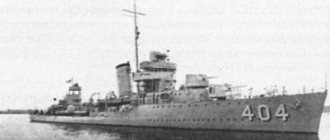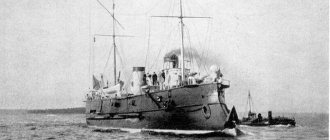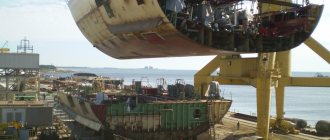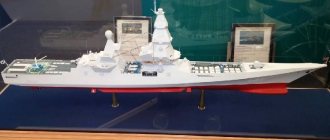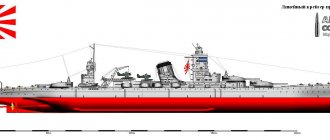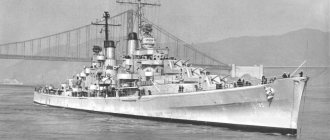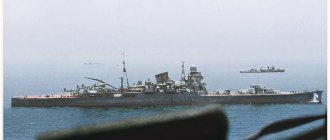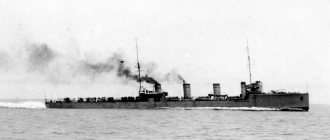Destroyer Zumwalt (Zamvolt) - the newest US destroyer
As I already wrote, after the 1980s, the mission of destroyers changed dramatically with the advent of Aegis technology. Destroyers were able to be armed with vertical launch systems for the use of cruise, anti-submarine and anti-aircraft missiles, which made it possible for these ships to provide cover for sea and land groups, as well as carry out massive strikes on land, sea and air targets.
Currently, the US Navy has 62 Arleigh Burke-class destroyers and 2 Zumwalt-class destroyers in service. Both types are equipped with the Aegis system, Tamagafk cruise missiles (Arleigh Burke up to 56, Zamvolt up to 80 missiles) and many other modern weapons.
The last Arleigh Burke-class destroyer was built in 2012, but the Navy plans to build 30 more. Arleigh Burke-class destroyers have been frequently used in combat in Libya and Syria.
"Zamvalt" are representatives of the latest technologies, built in 2013 and 2017. The appearance of these destroyers is very strange because... they use Stealth technology. All ships of this type operate exclusively on electricity.
From the point of view of personnel, on the one hand, these are professionals in their field, on the other hand, these are personnel who can tarnish their name so much that it can no longer be washed. For example, the captain of the destroyer Porter, which in April 2017 struck a Syrian air base, killing 72 civilians (27 children), is a woman, Andria Slough (maybe not the most humane, but the clearest example of professionalism). Another example is the commander of the destroyer Fitsgerald, in the same year 2017, without taking the necessary measures, collided with a container ship (I hardly think the command patted him on the head for this incident).
Performance characteristics
The most important parameters of Zumwalt-class destroyers are as follows:
| Ship length | 183 m |
| Width | 24.6 m |
| Draft | 8.4 m |
| Displacement (total) | 14,797 metric tons |
| Power plant power | 105,000 hp |
| Maximum speed | 30 knots |
| Crew | 148 people |
As is easy to see, in terms of its displacement and size, the ship roughly corresponds to heavy cruisers of the Second World War, and not to destroyers at all.
Power point
The electrical energy required to operate the onboard equipment of the “21st century destroyers” is generated by two Curtiss-Wright generators, which are connected to Rolls-Royce MT30 gas turbine engines. The power of each of them is 47,500 hp. (35.4 MW). In addition, the power plant includes two Rolls-Royce RR4500 auxiliary turbogenerators with a power of 3.8 MW each
Diagram of the USS Zumwalt combat information center.
The propellers are driven by AIM asynchronous electric motors manufactured by Converteam. Initially, it was planned to use quieter and lighter synchronous motors with permanent magnets from DRS Technologies.
The total power of the power plant is 105,000 hp, that is, 78 MW. The total electricity consumption (excluding electric motors) is approximately 20 MW. Theoretically, this makes it possible to place on board various laser systems or, for example, a railgun.
US destroyers in World War II
The rule “the more the merrier” showed its fruits during the First World War, so the US government continued to adhere to it. Having taken a break in the construction of destroyers (at that time, cruisers were mainly built), by the early 1930s the Navy again began building destroyers of the Farragut, Mahan, Dunlap, Porter, Somers, and Gridley types. , Bagley, Benham, Sims, Gleaves, Benson, Bristol and of course the great Fletcher. During the construction of new destroyers, in 1939, most of the old ones were removed from service or rebuilt into high-speed minesweepers, landing ships and minelayers. According to the 1940 treaty between the United States and Great Britain, 50 squadron Minnons were transferred to the Royal Navy, in exchange for the lease of military bases belonging to England.
"Porter"
The Porter ships are the first type of leaders - destroyers of the American fleet (all leaders before them were cruisers). They were followed by other Somers-class destroyer leaders. Thus, destroyers grew from auxiliary attack ships into attack ships themselves, which determined their importance in the future.
Fletcher-class destroyer - record holder and hero of World War II
Development of Fletcher began in 1939, but the construction decree was signed only in 1941. The main reason for the construction of the Fletchers was the lack of range of the Benson. Initially, the Fletchers were intended for use in the Pacific Ocean, but the situation during World War II made adjustments to their operation. A total of 175 units of this type were built between 1941 and 1943 (a record in the history of construction of one type of ship). Three of them were converted into seaplane carriers (“DD-477”, “DD-478” and “DD-480”). At the moment, there are 4 Fletcher destroyers, all of them converted into a museum.
In terms of general characteristics, this type was built in a “smooth-deck” style, which gave it an advantage in terms of weight. The second bottom of the ship appeared again, which improved their survivability. The ship's armor ranged from 12.7mm to 19mm, depending on the part of the ship. The 492-ton fuel reserve allowed these destroyers to travel up to 6,000 nautical miles at an optimal speed of 15 knots, and the maximum speed was 32 knots.
Model of the leader of the Fletcher-class destroyers
In terms of weapons, the Fletcher was equipped with fairly modern weapons for that time. It had Mark 12 (127 mm) class artillery, Bofors and Oerlikon class anti-aircraft artillery, anti-submarine weapons and mine-torpedo weapons. But the main feature was the fire control system, thanks to which the destroyer’s artillery was aimed automatically.
Thanks to their long range, the Fletcher destroyers sailed freely in the Pacific Ocean. The main naval battles of the US Navy took place in these waters. After the Pearl Harbor crisis, the American fleet intensified its operations in the Pacific territory. Battle of Midway, Operation Mo, Capture of Okinawa, Battle of Iwo Jima, Battle of Saipan, Battle of the Solomon Islands, Battle of Gualdacanal, Battle of Savo Island, Battle of Wake and of course the Battle of Leyte Gulf, followed by the Imperial Japanese Navy lost all hope for major actions by his fleet, are the Japanese-American naval battles, where the main trump card of the United States was the Fletcher destroyers.
Main design features of the “destroyer of the 21st century”
The Zumwalt cannot be confused with any other ship because its hull has a very distinctive shape: the sides are “tilted back” at an angle of about eight degrees from the waterline. The stem has an even more significant reverse slope of 45 degrees. Such a building in English-language sources is designated as tumblehome, which literally translates as “overturned house.”
A similar hull configuration was sometimes used before - for example, on the cruiser Aurora, the front part also has a reverse slope, although not as pronounced. At the turn of the 19th-20th centuries, the “overturned” bow was used to increase seaworthiness and simplify navigation when passing through narrow channels, but for the creators of the Zamvolt something completely different was important - they sought to minimize the radar signature of the destroyer. That is why its body was made in accordance with the requirements of the “stealth” technology already used in aircraft construction by that time.
Superstructure of the destroyer Zumwalt.
The most visible part of the destroyer is the huge superstructure, which contains radar, antennas, a bridge, a mast, various electronic equipment, and a hangar for an air group consisting of three MQ-8 Fire Scout unmanned aerial vehicles and one SH-60 helicopter. The take-off platform for them is located at the stern of the ship.
The bow deck is noticeably longer than the stern deck. It houses two AGS artillery mounts. The shape of the towers also takes into account the requirements of stealth technology.
The superstructure on the lead ship USS Zumwalt is made of composite materials and balsa (a very light and strong wood). These same materials completely cover the outer surface of the main hull with a layer approximately an inch thick. This solution, combined with the “reverse tilt” of the sides and stem, made it possible to reduce the size of the effective reflective surface to such an extent that, in terms of its radar signature, the destroyer differs little from a small fishing boat.
At the same time, however, the superstructures of the second and third ships in the series were made of ordinary steel in order to save costs. Of course, such a simplification largely contradicts the very concept of a stealth ship.
The “destroyer of the 21st century” does not have armor in the usual sense of the word. Kevlar is used to protect the most important elements of on-board equipment and ammunition.
On-board equipment
To actively search for targets, Zumwalt-class destroyers were initially supposed to be equipped with two main radar stations. The first of these is the AN/SPY-3, the first American shipborne radar with an active phased array antenna (PAA). The second radar was supposed to be the AN/SPY-4S decimeter range, but in 2010 it was decided to abandon it in order to reduce the price of the destroyer.
Locations for installing the radar (shown by red arrows).
As a result, the ship's anti-aircraft capabilities were noticeably reduced. Although “according to the passport” the target detection range using the AN/SPY-3 is almost 400 km, in practice guaranteed target designation for anti-aircraft missiles is provided at just over 50 km.
To search for submarines and sea mines, the following equipment is installed on board the Zumwalt:
- Sonar SQS-60. Works at medium frequencies.
- Sonar SQS-61. Operates at high frequencies.
- AN/SQR-20 is a complex consisting of a control system, an antenna array that is towed behind the ship and a multifunctional sonar.
Data collected by radars, sonars and various sensors is fed into an onboard computer network called The Total Ship Computing Environment Infrastructure (TSCE or TSCEI). The network includes 16 main computers running an operating system that is a special variant of Linux.
The ship's combat information center is equipped with numerous monitors and resembles a spacecraft mission control center rather than a conventional ship's control bridge. This room itself is made very spacious.
In addition, Zumwalt is equipped with fire extinguishing systems, numerous video cameras and control devices. All this equipment is as automated as possible.
US destroyers in World War I
Initially, Congress did not plan to enter World War I, adhering to the Monroe Doctrine, adopted back in the nineteenth century. However, under pressure from President Wilson, the United States nevertheless entered the war in 1917, a year before its end. Due to the fact that America was the last player to enter the war, it had enough time to complete its fleet.
In the first years of the war, 26 ships of 4 types of destroyers were built: Cassin (8), O'Brien (6), Tucker (6) and Sampson (6). The common feature of all these destroyers was their lack of speed. While European destroyers reached a maximum speed of 35-37 knots, American destroyers reached only 29 knots, which was a strong disadvantage at that time. However, the United States had its own reasons for this. The first was that high speed created a shortage of fuel. In order to fill this gap, it was necessary to increase the displacement, which the command did not want. Moreover, speed required high power, and this reduced the life of the engines, which was also undesirable. And of course it was all financial in nature.
Weeks-class destroyer
In 1916, Congress passed a law to expand the fleet. The rule “the more the merrier” became the basic principle of the Navy. For example, it was planned to build the first 50 “smooth-deck” destroyers of the “Wicks” type within two years. However, due to the fact that America became involved in the First World War, 111 destroyers of this type were built. An incredible figure that gave rise to the hegemony of the United States. Weeks is the second series of American destroyers. The main feature of this type was its speed, it could reach speeds of up to 35 knots and cruise at optimal speed (15 knots) up to 5,000 nautical miles.
Do you think a series of 111 destroyers built is a record? No, the next type of destroyer, the Clemson, developed in 1917-1918, was built in the amount of 156 units (and back this is not a record). Clemson is considered the third series of American destroyers. True, except for some weapons, it was no different from the previous one.
US destroyers played a significant role in the outcome of the war. The US deployed approximately 280 combat and support vessels, of which 64 were destroyers. At the cost of 7,000 personnel and 48 ships (mostly auxiliary), the world learned what the American Navy was capable of.
"Clemson"
